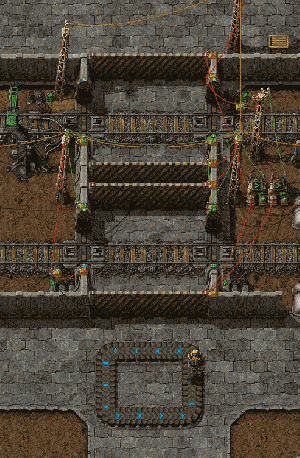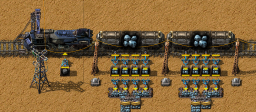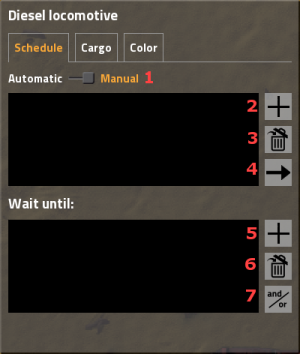User talk:JakubSTR
Welcome to the Official Factorio Wiki! Now that you have an account, there are a few key places on this Wiki that will be helpful in your efforts to improve it.
First and foremost, please be sure to read and understand the rules of this Wiki. If you have any questions or concerns with these rules, please don't hesitate to ask an Admin.
Secondly, if you're new to editing Wikis and are unfamiliar with MediaWiki's formatting, please be sure to read the help pages. In addition to the help provided by MW, we also provide a style guide that we enforce.
If you're unsure where to begin, please see the editor noticeboard, where information on the current objectives and projects of the Wiki may be found.
Again, welcome, we hope you contribute as much high quality information as you can. :) Bilka (talk) - Admin 10:58, 6 February 2018 (UTC)
Linki
https://wiki.factorio.com/index.php?title=Special:AllPages&namespace=10
https://wiki.factorio.com/Factorio:Editor_noticeboard
https://wiki.factorio.com/Factorio:Wanted_pages/pl
Railway - kolejnictwo
- Opis technologi: Railway (research)
Kolejnictwo jest jedną z głównych metod transportu w Factorio. Stworzenie sieci kolejowej jest skomplikowane oraz drogie, ale jest szybsze i wydajniejsze niż taśmociągi, czy też roboty logistyczne, szczególnie na duże odległości.
Sprawne zarządzanie pociągami, aby efektywnie wykorzystywać linie kolejowe wymaga czasu oraz doświadczenia.
Infrastruktura
Aby zbudować linię kolejową trzeba położyć tory, po których poruszają się pociągi. Zazwyczaj robi się to przez planer?. Tory kłaść można również ręcznie. Tory są układane na dwu-płytkowej siatce, dlatego nie można ich przesunąć 'o jedną płytkę'
Minimum konieczne do obsługi kolei
Do manualnej obsługi systemu kolejowego potrzeba:
Żeby wejść do lokomotywy i nią sterować, należy stanąć przy lokomotywie i nacisnąć ENTER.
Zwrotnice
- Nie ma dodatkowej wizualizacji zwrotnic. Tory mogą się łączyć i rozdzielać. Używając rail planer, gracz musi położyć tor na istniejący tor, aby utworzyć zwrotnicę. Zwrotnice umożliwiają na wybór kierunku jazdy pociągiem.
- Krzyżowanie się dwóch torów nie jest zwrotnicą, ponieważ pociąg potrzebuje odpowiedni promień skrętu. Nie mniej jednak, skrzyżowane tory łączą się w blok sygnałowy, aby zapobiegać kolizjom pociągów.
- Równolegle postawione tory nie działają na siebie. Gdy tory są zbyt blisko siebie to ich połączenie może się skomplikować. Aby zachować odpowiedni promień skrętu pociągu, może być potrzeba najpierw odsunięcia torów od siebie, a następnie połączenia ich. Może to stworzyć skomplikowaną sieć bloków, sygnałów, a w konsekwencji sprawić, że wybudowane tory będą bezużyteczne. Najlepszą odległością pomiędzy równoległymi torami jest miejsce na dwa tory.

Przechodzenie przez tory
Trzeba uważać przy przechodzeniu przez tory. Pociągi są najniebezpieczniejsze w grze - zabierają najwięcej życia. Przeważnie od razu zabijają gracza.
Sposób na przejście przez tory:
- Zwiększ zoom, aby widzieć więcej planszy.
- Rozejrzyj się w lewo i w prawo.
- Spójrz na najbliższą sygnalizację. Jeżeli semafor nagle zmieni kolor z zielonego na żółty lub czerwony oznacza, że zbliża się pociąg. Nie przechodzić.
- Unikaj chodzenia blisko, wzdłuż torów. Nie musisz być w całości na torach, aby być trafionym.
- Możliwe jest wsiadanie i wysiadanie z pociągu w trakcie jazdy. Trzeba tylko uważać, żeby nie wylądować zbyt blisko pociągu, gdyż może to kosztować życie.
- Ciężki pancerz i tarcza energetyczna może zredukować obrażenia od pociągu. W skrajnych przypadkach możliwe jest zatrzymanie pociągu własnym ciałem. Potrzeba w tym celu dużo tarcz.
- Każda jednostka, która posiada zdrowie może być zniszczona przez pociąg. Dlatego trzeba uważać, aby nie stawać samochodem, czy też czołgiem na torach. Na szczęście, ta zasada dotyczy również wrogów.
- W zasadzie pociągi mające daleko do przystanku lub semafora będą poruszać się blisko maksymalnej prędkości. Zbliżając się do przystanku lub semafora będą zwalniać w celu zatrzymania. Maksymalna prędkość i przyspieszenie pociągu zależne jest od załadunku (połączonych wagonów).
Można zbudować bezpieczne przejście kolejowe, jak w przykładzie na zdjęciu. Ogranicza dostęp do przejścia, gdy pociąg zarezerwował sobie dany odcinek torów. A kiedy gracz jest na torach, odcinek jest zarezerwowany dla gracza i zatrzymuje pociągi do momentu, aż gracz przejdzie. Jest to całkowicie bezpieczne przejście i jest często używane przez graczy na serwerach.
Trains
Train components:
| Locomotive | Cargo wagon | Fluid wagon | Artillery wagon |

- A train consists of at least one locomotive.
- Trains can have more than one locomotive, and any number of Wagons.
- Locomotives can be manually driven forwards or backwards, however, they are generally slower going backwards. The left and right movement keys are used to change direction at switches.
- Trains can only drive forwards automatically. An automatic train can drive forwards and backwards when two locomotives facing different directions are connected to the train.
- A train needs fuel to drive. Fuel can be added by inserters when the train is in manual mode or parked at a station, not when waiting at a signal or standing on automatic mode.
The locomotives' inventory is only used for fuel. To transport items or fluids cargo wagons and/or fluid wagons have to be attached to the train. To attach rolling stock, whether a wagon or a locomotive, the player may either prepare to place one near an existing train, where a green graphic will show the player that the stock will be attached, showing a connection between the train and the new stock. Alternatively, the player may manually connect rolling stock to trains with the rolling stock connect key, if the cargo wagon was placed far away from a train. Rolling stock can likewise be disconnected with the rolling stock disconnect key. The cargo wagons can be filled or emptied manually or by up to twelve adjacent Inserters (six on each side), while fluid wagons can be filled or emptied with up to three pumps, which will automatically connect to the nipples on top.
Stations

Station Components:
| Train stop | Rails | Inserters or Pumps |
A train station is a combination of at least one train stop plus a storage and/or distribution system, used to fill or empty cargo wagons and/or fluid wagons, load fuel into the locomotive(s), load ammunition into artillery wagons, or repair trains.
Don't mix up train stations with train stops. A train station is a concept, whereas a train stop is an item.
Inserters placed next to train tracks are used to load/unload trains at train stops. Inserters are the only way to automatically get items out of and into cargo and artillery wagons; pumps are the only way to automatically get fluids into and out of fluid wagons.
Signals
| Rail signal | Rail chain signal |
Rail signals are used to employ multiple trains automatically without the danger of trains crashing into each other. Rail signals split the network into blocks and ensure that only one train can be in every block at any time. Note that driving a train manually ignores all signals; so it is possible for automatic trains to crash into the player if the player ignores red/yellow signals. Always beware of automatic trains and give them the right of way.
The train signals tutorial contains an in-depth explanation of rail signals, blocks and deadlocks.
Basic Signaling Rules
- There can only be one train in a block at any time. A train spanning multiple blocks occupies them all.
- A red signal means that the following block is occupied by a train.
- A yellow signal means that a train is approaching and already has the approval to enter the following block.
- Rail signals separate a new block and reflect its state: green - free, yellow - reserved, red - occupied
- Rail chain signals separate a new block and reflect the state of the next Rail signal(s): see above, blue - at least one of the paths is blocked, but not all
- A train can only pass a signal on the right of the track, or if there is a signal on both sides on the same rail segment. Of course, manual driving overrides this.
Automated transport

Trains set on "Automatic" choose their destination stop and route on departure, and after waiting at a chain signal for five seconds, and when their destination stop disables itself by circuit condition. They choose the shortest route using a path finding algorithm that will get them to an enabled train stop with the right name, taking penalties for any apparent-at-the-time delays into account. If no such train stop exists they will skip the stop and go on to the next.
This section covers items used to make trains automatically transport items between stations. The player should be familiar with creating a rail system.
First, the player has to setup a rail system with at least two train stops, which are placed in the right-hand side of the expected train arrival direction. By hovering over the train stop with the mouse you see the positions of the vehicles for better setting up the train station (including (un)loading machinery, refueling/repair installations).
When you set up the train schedule (see below) and fuel the train, you can start the train on it's schedule by switching from manual to automatic driving mode.
Train schedule
The player can set up a list of train stations in the upper window. The train will route to stops in the given order, if it's at the end it will continue with the first. Currently, it's not possible to make a one-time schedule. Stations can be added by clicking button 2 (see picture). A pop-up appears with a list of all stop names. If you select one, another pop-up appears for you to select a wait condition.
Wait conditions are used to tell the train when to leave the station. There are 7 types of wait conditions:
- Time passed
- Inventory full – All inventories of the train are full.
- Inventory empty – Same as above, but empty.
- Item count – The train (all cargoes summed) contains a specific amount of a certain item.
- Circuit condition – The train stop is connectable to the Circuit network, so the signals can used for wait conditions.
- Inactivity – No items were added or removed for the specified amount of seconds.
- Fluid count – The train (all fluid wagons summed) contains a specific amount of a certain fluid.
Hereafter the word "term" is used to describe one type of wait condition, and the words "wait condition" are used to describe the whole set of terms (it turns a bit into maths).
If you add more than one term, you can change the connection of those using the logical operators AND and OR (button 7). An AND condition will result in true if all terms are true. An OR condition will return true if at least one of the terms is true.
When mixing AND and OR terms, the logic is grouped by the OR terms. When evaluating the wait condition, the first term is evaluated along with all AND terms immediately following up to but excluding the next occurring OR term. If they all evaluate true, the wait condition evaluates true. Otherwise, evaluation continues with that next occurring OR term and all AND terms immediately following it, up to the next OR term. This continues until either an OR group evaluates true and the wait condition is satisfied, or all terms have been checked.
Examples
Expand for examples
Wait until full, up to 30 seconds:
Full cargo inventory OR 30 seconds passed
Wait until cargo full, or circuit condition Oil > 3000:
Full cargo inventory OR Circuit condition - Oil > 3000
Wait until empty, and 30 seconds passed, and 5 seconds of inactivity:
Empty cargo inventory AND 30 seconds passed AND 5 seconds of inactivity
Wait until iron ore is low, or copper ore is low and at least 30 seconds passed:
Cargo: Iron ore < 500 AND 30 seconds passed OR Cargo: Copper ore < 500 AND 30 seconds passed
Factorio's wait condition logic is read as disjunctive normal form (DNF), and so this last example is processed as (note the parenthesis):
((Cargo: Iron ore < 500 AND 30 seconds passed) OR (Cargo: Copper ore < 500 AND 30 seconds passed))
Which is the same as this:
((Cargo: Iron ore < 500 OR Cargo: Copper ore < 500) AND 30 seconds passed)
Unfortunately, there is no way to write that shorter form in the current UI.
Troubleshooting
Below are some things to verify if a rail system or train is not working.
- Is the train fueled? Ensure that the locomotive has fuel of some kind.
- Misplaced or non-functional switches? Ensure that the train can plan a path through the switches.
- Another train on the same block? Make sure the path of the train is unobstructed.
- Train stops placed correctly? Make sure that the yellow arrows when hovering on the stop point towards the end or exit of the stop.
- Is the train allowed to enter signals from the right direction? Are the signals set correctly?
- If a track is supposed to be two-way, the rail signals should be opposite each other. You can verify they match up by hovering the cursor over one. For a matched pair, it will show the other.
No path
When trains cannot reach the target, a "no path" symbol pops up over the locomotive. Check:
- Can the train reach its current destination by only driving forward? Build turning slopes or place a locomotive at both ends of a train!
- Are the train stops standing in the right direction? Train stops must be on the right hand side of the track.
- If you use rail signals, check that the signals are all allowing traffic in the correct direction.
- Check for interruptions in the train tracks, drive to the station manually to check there are no rail parts missing. Especially near junctions these can be hard to spot if missing.
If you are still having problems, consider:
- Driving the train manually, and as you pass each switch, try switching to automatic. When it works, you will know the rough area of the problem.
A pictorial summary of typical problems.
Achievements

|
Trans-Factorio express Have a train plan a path 1,000 tiles or longer. |
Connection to OpenTTD
Factorio's railway system works basically exactly like the block signals in Open Transport Tycoon Deluxe. Players who have ever played that game will find some elements of it in Factorio. If not, they can learn from the OpenTTD documentation.